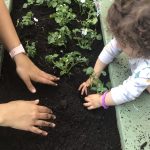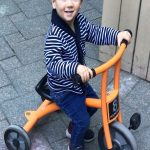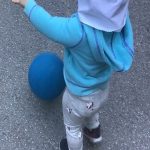Outdoor Play
Description and Learning Objectives
We all know how much much children love to be outside. Young children need plenty of open space to spread out and move! They need space where they can practice their skills of movement, balance, coordination, and be provided with the opportunity for gross motor development. Playing outside also helps fosters children’s other developmental skills such as social, emotional, and cognitive skills. The playground is an extension of the learning environment they have inside, that’s why it is important to allow children the opportunity to experience outdoor play throughout their day.
Materials
Activities that encourage children to move their bodies and a variety of toys that may be too large to be used inside (e.g. bikes, scooters, large balls, and bubbles).
Observations and Findings:
Activities such as running, hopping, climbing, riding the tricycles, or just playing with the balls are all gross motor activities that aid in the development of children’s large and small muscles. Having a large open area for children to do all these physical movements encourages them to move their bodies and build on emerging skills. For example, a child who is learning to walk can use a push toy outside to assist them with their body’s movements and coordination. As they master ways in which they can move their bodies, they will gain a better sense of self, and feel proud of their accomplishments. As such, outdoor play also supports their emotional development.
Outdoor play is also beneficial for children’s health. Regardless of the weather, having children be outside for even a small amount of time allows them to breathe in fresh air and experience nature as a whole. They can observe not only how the outside environment changes physically such as leaves changing colours, but also how the same weather can have different experiences depending on the season (sunny day in summer versus sunny day in winter). Doing outdoor-nature-based activities such as planting also allows children a better understanding of how they can be a part of their community and how something can flourish and grow as long as we take the time to nurture it.
As teachers, we have observed that children gain more than just gross motor skills while playing outside on the playground. Whether children are playing in groups or even side by side, we have seen how children are able to build on their social skills through the interactions they have with their teachers and peers. Outside we can see children enjoy running and chasing each other as well as work together on activities. This helps build relationships and provides children with the opportunity to develop their expressive and receptive language skills. Children who prefer to play on their own also continue to watch the interactions among the other children and teachers. They may use these observations to help build their imitation skills and set a foundation of understanding on ways human interact with one another within their society.





